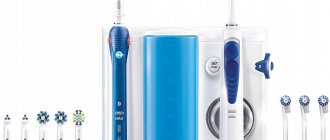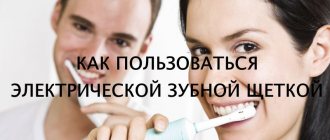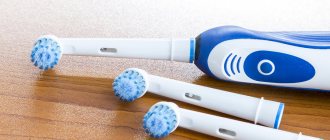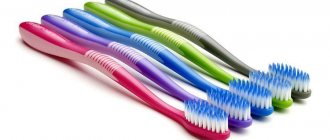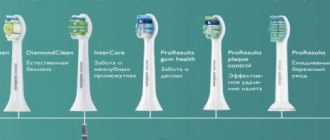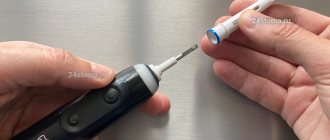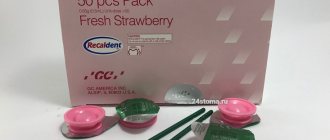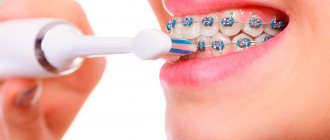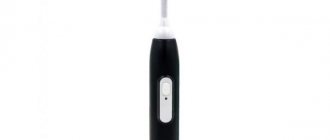- Electric or manual toothbrushes
- Recommendations for choosing a children's electric brush
- How does a brush motivate you to brush your teeth?
Do you want your child to have healthy teeth and gums and visit the dentist’s office less often?
Instill in him the healthy habit of brushing his teeth regularly. In 2014, the World Health Organization (WHO) announced global statistics on dental diseases. According to it, almost 100% of adults and 60–90% of children have caries.
The main risk factors include poor diet and poor oral hygiene. As a preventative measure, WHO recommends reducing the amount of sugar in your diet, including more fruits and vegetables, and maintaining good oral hygiene.
Seems simple? But instilling in your child the habit of brushing their teeth twice a day is not such an easy task. To solve it, you need to interest the baby by turning hygiene into a game. A children's toothbrush should not only be safe, but also interesting.
When is the best time to start brushing children's teeth?
Correct, healthy habits are established in early childhood. This statement also applies to oral care. How competently parents teach their child to brush his teeth determines his future health and self-confidence. According to experienced doctors, it is worth starting to monitor oral hygiene even before the eruption of baby teeth. At first, experts advise wiping your gums with a piece of soft gauze soaked in warm boiled water. The procedure must be done twice a day.
When the baby's first teeth appear, parents are advised to get a special rubber brush. It is placed on the finger and gently cleans children's gums and teeth.
But you can start introducing a real toothbrush at about 1.5 years of age.
Choosing a brush according to age
Age from 1.5 to 3 years
To begin with, you should purchase a manual toothbrush with ultra-soft bristles that is appropriate for your age. It’s better to choose a model with a picture or pen in the shape of an animal or a favorite cartoon character so that the item evokes sympathy. Make sure that the child does not chew it, but rather brushes his teeth - otherwise it will be problematic to teach him proper hygiene.
Age from 3 to 7 years
When your child turns three years old, you can try offering him an electrical sample. The advantage is that such brushes have great opportunities for interaction, which means kids who did not like conventional devices may become interested in the new product. For children aged 3 to 6-7 years, dentists recommend choosing an electric brush with the softest bristles; you can use it in turn with a regular one (but also soft). Preschoolers must use an electrical device exclusively under the supervision of their parents.
Age from 8 to 13 years
When your child turns 8 years old, you can purchase a brush head of the same brand as his regular children's brush, but for sensitive teeth. It is slightly stiffer than directly on devices for very young children, but at the same time much softer than on adult models. Such a purchase can serve as a good option for a changing bite until the time comes to switch to a device with standard bristles.
Ages 13 years and older
Teenagers over 13 years of age can use electric brushes with medium-hard bristles. Of course, choosing an oral hygiene product is an individual matter, so you should buy it only after consulting with a dentist and assessing the condition of the enamel. If the doctor says that it is too early to switch to medium bristle hardness, then continue to purchase attachments for sensitive teeth.
Recommendations for purchase
In addition to the fact that the age restrictions indicated on the packaging must correspond to the age of the child, it is worth considering other characteristics.
Pen
It is important to pay attention not only to the shape, but also to the material from which the handle of the product is made. For younger children, it is better to choose a long handle with a rubberized texture so that it does not slip out while brushing their teeth.
It is good that the child’s favorite character is depicted on its surface and there are no three-dimensional elements. Older children can choose the design of the product themselves.
Working part
For children who have just begun to get acquainted with a brush, the parameters of the product head should be minimal in order to avoid a feeling of discomfort while brushing their teeth and damage to the oral mucosa.
The optimal length of the working part, which should have a rounded shape, for children aged 0 to 2 years should be no more than 2 cm, and for the older generation - approximately 2.3 cm.
When replacing milk crowns with permanent ones, you should purchase a model identical to an adult brush, but with smaller head parameters.
Bristles
In this case, the criteria are applied to the material and degree of rigidity. It is not recommended to purchase models with natural fibers, which serve as an excellent breeding ground for pathogenic bacteria.
A brush for little ones should have soft, elastic bristles. Starting from the age when a child’s diet includes the same products as an adult’s menu, you should change the model to a product with a medium-hard working part in order to efficiently remove food residues.
Children with characteristic large gaps between teeth need to use a product with V-shaped tufts of bristles. It is worth noting that the length of the villi should not exceed 1 cm.
Presence of timer and cleaning mode
An additional timer function makes it convenient to control the duration of the teeth brushing process.
The ideal option would be the ability to adjust the intensity of the brush and its degree of pressure on the enamel, which would make it possible to select the optimal technical characteristics individually for the characteristics of the child’s oral cavity.
See photos of toothbrushes for braces and learn about their types. Click here if you are interested in treating an abscess on a child’s gum.
At this address https://dr-zubov.ru/lechenie/desny/izbavlenie-ot-zabolevanij-s-plazmoliftingom.html watch a video about the plasma lifting procedure in dentistry.
Manufacturer reliability
As practice has shown, manufacturers of electric brushes that have proven themselves on the positive side do not change their principles and produce high-quality products.
Today, manufacturers also provide the opportunity to choose one of three types of models: mechanical, sound or ultrasonic.
For children under 6 years of age, it is better to give preference to the first option. It is this type of product that gently affects the surface of the teeth, thoroughly removing plaque. An older child can purchase a sound model.
Ultrasonic brushes are not intended for safe oral care for children.
For more information on choosing toothbrushes for young children, watch the video.
Types of electric brushes: which ones are suitable for children
The classification of dental care devices is common to everyone – both children and adults. However, not every gadget is suitable for a baby. Therefore, we will further consider those options that are approved for use in children.
Read on the topic: how to choose a good electric toothbrush for an adult - all types of popular devices in one detailed material.
- Classic model. The operation of a standard (or classic) device is based on the action of a miniature motor that drives the brush head. The bristles move back and forth or in a circle (and back) at a given speed, cleaning out food debris and plaque.
- Sound type. These models have a built-in generator, thanks to which the brush head emits high-frequency sound vibrations. They destroy deposits on enamel with greater efficiency and promote better formation of foam from toothpaste, which washes out even the smallest impurities well. Children can use such a brush, but under the supervision of adults and always under the supervision of a doctor - it is important to understand that sound waves do not cause harm.
- Ultrasonic type. The head of such a brush does not just move, the device produces ultrasonic waves that destroy dirt and germs. The frequency of ultrasound is about 40-50 thousand vibrations per minute. Therefore, such models are contraindicated for children, since the effect of ultrasound is detrimental to fragile enamel; it quickly destroys areas with weak mineralization.
Peculiarities
- Electric toothbrushes can be battery operated or rechargeable. The second option is more expensive, but also of higher quality.
- Children's brushes differ in the size of the attachments. So, for the little ones it is worth choosing small heads.
- The effectiveness of cleaning depends on the density of the bristles.
- If you are concerned about the material of the bristles, then it is better to opt for an artificial material, such as nylon. Natural hair is hollow inside and retains water, in which microbes subsequently multiply.
What to look for when choosing
The stiffness of the bristles
As already mentioned, children's teeth are more vulnerable to decay than those of adults. Milky enamel is more fragile because contains less calcium and phosphorus. And the natural process of remineralization often fails due to the large number of harmful foods in the diet, this must be taken into account. That's why electric brushes for babies are distinguished by soft and fine bristles, so that cleaning is as gentle as possible.
Good to know! If you already have an “adult” brush at home with a gentle cleaning mode, when the device works without pulsating, it will be quite suitable for a child over 7 years old. Of course, you will need to buy a separate attachment that is suitable for the baby in terms of softness and size.
2. Equipment - nozzles, operating modes and sensors
Electronic hygiene products can be programmed to operate in multiple modes and come with multiple attachments for different purposes. For example, the kit may include a head for massaging the gums, cleansing the tongue and cheeks. The most useful functions for such a device are a pressure sensor and a timer that measures the cherished 2 minutes of cleaning. They will help control the procedure time and prevent damage to sensitive enamel.
“Since my son started brushing with an electric brush, his teeth have become much whiter, and the plaque on his gums no longer accumulates in the same amount. And he himself became much more interested in using such a fashionable gadget. And the built-in timer is just a godsend for kids. It works every 30 seconds, changing the vibration frequency. So it becomes clear that it’s time to clean another area.”
Miura, review from irecommend.ru
3. Please pay attention to age restrictions
When buying an electric brush, you need to make sure that its characteristics are optimal for the baby’s age. The packaging usually states what age category the device is intended for: from 3, 5, 6 or 7 years old.
Electric brush power method
Which gadget to buy—battery-powered or rechargeable—is another important question. The first ones operate on one power source for up to three months, then the battery will have to be replaced. The device with the battery is charged from the network. Energy lasts for an average week.
Availability of a mobile application
Children over 5 years old will be delighted with the brush with the option of synchronizing with a smartphone. A special application is installed on the phone, through which the little researcher can track his progress and receive valuable advice on improving his skills.
Good and bad brushes. How to distinguish them?
First, study the case. What material is it made of? If it is cheap Chinese plastic, with backlashes and gaps, an unpleasant chemical smell, etc., we immediately reject this option.
The second point is the bristles. Children's teeth are much more sensitive than adults. This is due to the fact that the level of enamel mineralization is still very low. Therefore, it is necessary that the brush does not damage it.
At the same time, too soft bristles will be useless. It is not able to remove plaque particles from the surface of the teeth. Therefore, such cleaning will not remove plaque. Over time, this will lead to logical consequences - caries.
Correct holding and application
Choose a device so that its handle fits comfortably in a child’s palm and does not slip. Discuss with your child what the brush “can do” and how it works. Then learn how to hold it. Watch the training video together. Videos with cartoon characters, funny characters, or kids the same age as the main characters will come in very handy. Show how to move the brush correctly in the mouth, explain that you need to spend time on each tooth - this is important.
On a note! You can learn more about how to properly brush your teeth with an electric brush from another thematic material.
Children aged 5 years and older can easily cope with the task themselves, but mothers and fathers should still keep an eye on the baby. It will be great if joint oral hygiene becomes a family tradition.
Electric toothbrushes or manual ones?
In any case, a child should be able to use a manual brush - this is an important skill that develops motor skills. At an early age, up to 4 years, it is better to combine the use of manual and electric brushes.
Yes, you can brush your teeth equally effectively with an electric toothbrush and a manual toothbrush. However, even adults usually fail to follow the manual cleaning technique, let alone children. The task is further complicated by not only teaching, but also motivating the child to good hygiene. An electric brush is a simple and convenient way to achieve clean teeth with minimal effort.
And using an electric brush can be presented as a game. Bright colors, replaceable panels, funny stickers and a soft buzzing put older children in a positive mood, and allow little ones to cope with the fear of the dentist's office - the doctor's buzzing instruments will no longer seem so unfamiliar and unpleasant.
How to teach your child self-hygiene
It is best that adults, by personal example, introduce their son or daughter to self-care from early childhood and show that it is pleasant and useful. Oral hygiene should be carried out in the form of role-playing games, using your favorite toys. As a rule, children willingly copy the behavior of their parents if they want to show off their size and take part in something interesting.
It is important to know! Do not force or intimidate your child into brushing their teeth. Do not try to get him to perform all manipulations regularly and within a strictly allotted time from the first days. This approach will discourage you from picking up a brush and toothpaste for a long time, and the procedure itself will be associated only with negativity.
Simple moves. Nozzle operation
Brushes with a motor have three options for movements made by the nozzle:
- 1D – normal rotation;
- 2D – instead of circular movements, reciprocating movements are performed. This is much more effective.
- 3D – combining reciprocating action and pulsation. This method of cleaning teeth is considered more effective in removing plaque.
Selection of nozzles
Some models are equipped with several different attachments. For others, add-on kits may be sold, such as electric floss, attachments for sensitive teeth, or for deep cleaning. It is very convenient when there is a good choice for the chosen model.
It is believed that the optimal height of the bristles should not exceed 10 mm. Ideally, the presence of bristles of different heights.
Contraindications for using the device
Dentists name several main factors when the use of an electric toothbrush by a child is contraindicated:
- the presence of wedge-shaped defects: we are talking about depressions that appear at the base of the tooth and can increase over time, exposing the neck. Intense mechanical impact contributes to the development of this pathology,
- bottle caries: it occurs in babies who are often fed milk, formula, or foods containing a lot of sugar (including juices, cookies) before bedtime. Leftover food is an ideal breeding ground for microbes that destroy enamel. As a result, first whitish, then brownish spots appear on the enamel layer. These areas should not be subjected to strong pressure, otherwise the situation will worsen,
- high rate of enamel abrasion: occurs quite often in children. The cause may be an incorrect bite or a not well-studied disease such as bruxism (grinding teeth during sleep), as well as heredity and fragility of enamel caused by various diseases,
- the presence of areas of enamel with low mineralization: white spots - the first harbingers of caries. If a child experiences such phenomena, an electric brush is contraindicated for him. First you need to undergo a remineralization course, otherwise the device will do more harm than good,
- Gum disease: Another reason to put off using a powered device. Even soft stubble can aggravate inflammation, so the first step is to get rid of the troublesome ailments.
Tips for choosing
Choosing an electric toothbrush for a child is in many ways similar to choosing a toothbrush for an adult. It is worth remembering that there are only two types of brushes for children: standard and sonic. The former are equipped with soft bristles, while the latter may seem unusual to the child due to the noise.
Consider the speed of movement of the bristles: the higher it is, the more intense the cleaning. Accordingly, for the little ones it is worth choosing brushes with less vibration.
Also, for the little ones and for those who use a brush for the first time, the habituation function to the brush may be useful, as well as the built-in pressure sensor on the teeth.
Synchronization with a smartphone is suitable for kids who have yet to learn how to brush their teeth properly.
The best electric brushes for children
Below are models that are recommended by dentists and parents according to numerous reviews.
Oral-B Stages Power – from 3 years
A worthy representative of the family of classic brushes for ages from 3 years. Available in a set with a stand and a single round nozzle (but replaceable). Cleans in standard mode and makes up to 7600 movements per minute. It takes energy from the battery, which provides about 30 minutes of continuous operation. There is a timer and bristle wear indicator. The device has an original design, for example, in the style of the cult film “Star Wars”, “Cars” or with princesses. This gadget will appeal to both boys and girls.
The downside is that there is no pressure sensor and the attachments for changing are quite expensive (about 300-400 rubles apiece). The best price is 1100 rubles. Average – 1500 rubles.
Philips Sonicare For Kids – from 3 years
Sound model for children from 7 years old (but can also be used from 3 years old, you just need to choose an ultra-soft nozzle). The set includes a storage stand and two elongated attachments designed for different ages - from three years and from seven years. Each operates in two modes – standard and delicate. Operates1 at a maximum speed of up to 31 thousand pulsations per minute.
The device is powered by a built-in battery. It has a maximum range of functions: the option of gradually getting used to the device, a charge indicator, a timer and a pressure sensor on the tooth. The device communicates with an application on a smartphone via Bluetooth. Thanks to this, the child gets the opportunity to learn how to brush their teeth in a playful way, following the advice of a virtual character. The application has a motivation system: the child receives encouragement for all successes. Thus, the device turns the procedure into an exciting quest. The device comes complete with eight colored stickers for the handle, which depict funny animals. Exactly what was described above - positive emotions create the right mood.
The downside is that the cost is quite high. The best price is 5190 rubles.
CS Medica SonicPulsar Junior – from 5 years
An affordable and high-quality sonic brush for children over 5 years old. The body is complemented by a rubberized handle for the convenience of the small owner. Comes in a set with two elongated nozzles, equipped with bright LED lighting. Together with the beautiful color of the hand, it creates a mood and attracts the child’s attention. It operates in standard mode and produces up to 16 thousand pulsations per minute. Operates on a battery, the charge of which lasts for up to five months. There is a timer to control the cleaning time. After two minutes of operation, the device turns off automatically.
The downside is that there is no pressure sensor or bristle wear indicator. The best price is 800 rubles.
Oral-B Junior – from 6 years of age
A classic, high-quality electric brush for a 6-year-old child. Comes with a storage stand and a single round shaped head. Cleans in standard mode. Powered by a battery and charged from the mains. The power source energy lasts up to 10 days. There are charge level and bristle wear indicators, as well as a timer.
The downside is that there is no pressure sensor. The best price is 2000 rubles.
Popular brands
Children's electric brushes are produced by many companies. But you need to give preference to proven well-known brands. They engage in research and implement new technologies, so they produce high-quality products.
Oral-B
The most popular models are produced under this brand. They are easy to use, inexpensive, and have a timer that teaches your baby to brush their teeth for a certain time. All brushes are beautifully designed and have a comfortable non-slip handle.
Philips
The brushes are produced with a bright design, the handle is decorated with drawings of your favorite cartoon characters. The head is oval, standard size. The devices have a timer, a cleaning mode, and Bluetooth.
CS Medica
The company has developed a bright design especially for children. The operating principle is based on sound vibrations. Can be used from 2-3 years. Has backlight, timer, low weight.
Hapika
This Japanese brand produces different models for children from 3 years old. They have a small head with soft, rounded bristles. Hapika brushes create sound vibrations that gently clean children's teeth. They are light and do not make much noise.
